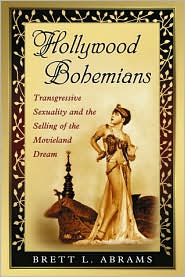
Brett L. Abrams'
Hollywood Bohemians drew me as a reader with a fairly simple claim: the studio-era film industry used its social deviants (homosexuals, transvestites, adulterers, etc.) to depict and promote the image of Hollywood as a place of glamour and sexual freedom. As a student of both films and GLBT history, this thesis intrigued me. Unfortunately, this book leans far more heavily towards the 'thesis' than the 'intrigue,' and that thesis is problematic.
The writing is wooden and formulaic in a manner that would make an excellent parody of academic theses were it not an actual academic thesis. In a typical section, Abrams excerpts a gossip column article or movie clip loaded with coded slang for gay men or lesbians, spends another paragraph or three dissecting the excerpt, and then spends another page expounding on the "titillation" this information would have provided for the general public. There is ample repetition from sentence to sentence, and the author appears overly fond of his coined term, 'Hollywood Bohemians'. A few well-placed conjunctions and pronouns might have reduced this book by 20 pages while making it more readable.
The structure of the book, with each chapter devoted to depictions of stars' lives in a different Hollywood setting, is a wreck. Abrams divides the settings into nightlife (restaurants & clubs), public & semi-public parties (premieres & awards shows), private parties, home life, and the studio backlot. This conceit's unwieldly compartmentalization fails in its sheer artifice, as if these "settings" were mutually exclusive categories. It also fails to capture any sort of historical narrative, which results in some literary gymnastics. Frequently when a new persona arises in connection with a star, the author is forced to deal with her in a later chapter to maintain the conceit rather than take the natural transition.
The inclusion of Hollywood-themed novels among the excerpted material was something I found irksome, particularly when Abrams used it as the primary evidence of his claims about Hollywood life. While one can certainly argue that the novels are reflective of the history, this seems more akin to arguing that Agatha Christie's Poirot novels are emblematic of early 20th century criminal science. Finding more information on the general public's reaction to some of these portrayals would have been more successful. Were members of the public indeed titillated, or did the author simply cull a large number of obscure news clippings that most Americans would not have seen?
Abrams brings to light some aspects of Hollywood's GLBT history that have largely fallen by the wayside and includes some choice archival photographs, all of which displays his skills as a researcher and archivist. The nearly 40 pages of references in the endnotes and bibliography provide copious paths for further research, whether by the academic or layperson. In the end, however, the writing style and lack of coherent structure leave me unable to recommend this work to others.
Thank you to McFarland Publishing for the opportunity to review this book.Originally posted @ LibraryThing on January 9th, 2009.


